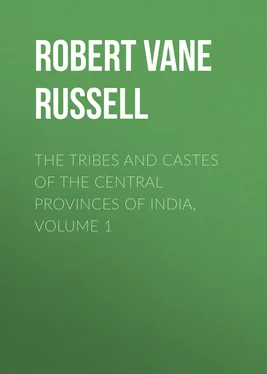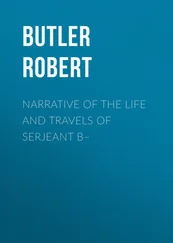Robert Vane Russell - The Tribes and Castes of the Central Provinces of India, Volume 1
Здесь есть возможность читать онлайн «Robert Vane Russell - The Tribes and Castes of the Central Provinces of India, Volume 1» — ознакомительный отрывок электронной книги совершенно бесплатно, а после прочтения отрывка купить полную версию. В некоторых случаях можно слушать аудио, скачать через торрент в формате fb2 и присутствует краткое содержание. Жанр: foreign_prose, История, foreign_edu, foreign_antique, на английском языке. Описание произведения, (предисловие) а так же отзывы посетителей доступны на портале библиотеки ЛибКат.
- Название:The Tribes and Castes of the Central Provinces of India, Volume 1
- Автор:
- Жанр:
- Год:неизвестен
- ISBN:нет данных
- Рейтинг книги:5 / 5. Голосов: 1
-
Избранное:Добавить в избранное
- Отзывы:
-
Ваша оценка:
- 100
- 1
- 2
- 3
- 4
- 5
The Tribes and Castes of the Central Provinces of India, Volume 1: краткое содержание, описание и аннотация
Предлагаем к чтению аннотацию, описание, краткое содержание или предисловие (зависит от того, что написал сам автор книги «The Tribes and Castes of the Central Provinces of India, Volume 1»). Если вы не нашли необходимую информацию о книге — напишите в комментариях, мы постараемся отыскать её.
The Tribes and Castes of the Central Provinces of India, Volume 1 — читать онлайн ознакомительный отрывок
Ниже представлен текст книги, разбитый по страницам. Система сохранения места последней прочитанной страницы, позволяет с удобством читать онлайн бесплатно книгу «The Tribes and Castes of the Central Provinces of India, Volume 1», без необходимости каждый раз заново искать на чём Вы остановились. Поставьте закладку, и сможете в любой момент перейти на страницу, на которой закончили чтение.
Интервал:
Закладка:
17. The mixed castes. The village menials
But though among the four classical castes it was possible for the descendants of mixed unions between fathers of higher and mothers of lower caste to be admitted into their father’s caste, this would not have been the general rule. Such connections were very frequent and the Hindu classics account through them for the multiplication of castes. Long lists are given of new castes formed by the children of mixed marriages. The details of these genealogies seem to be destitute of any probability, and perhaps, therefore, instances of them are unnecessary. Matches between a man of higher and a woman of lower caste were called anuloma , or ‘with the hair’ or ‘grain,’ and were regarded as suitable and becoming. Those between a man of lower and a woman of higher caste were, on the other hand, known as pratiloma or ‘against the hair,’ and were considered as disgraceful and almost incestuous. The offspring of such unions are held to have constituted the lowest and most impure castes of scavengers, dog-eaters and so on. This doctrine is to be accounted for by the necessity of safeguarding the morality of women in a state of society where kinship is reckoned solely by male descent. The blood of the tribe and clan, and hence the right to membership and participation in the communal sacrifices, is then communicated to the child through the father; hence if the women are unchaste, children may be born into the family who have no such rights, and the whole basis of society is destroyed. For the same reason, since the tribal blood and life is communicated through males, the birth and standing of the mother are of little importance, and children are, as has been seen, easily admitted to their father’s rank. But already in Manu’s time the later and present view that both the father and mother must be of full status in the clan, tribe or caste in order to produce a legitimate child, has begun to prevail, and the children of all mixed marriages are relegated to a lower group. The offspring of these mixed unions did probably give rise to a class of different status in the village community. The lower-caste mother would usually have been taken into the father’s house and her children would be brought up in it. Thus they would eat the food of the household, even if they did not participate in the sacrificial feasts; and a class of this kind would be very useful for the performance of menial duties in and about the household, such as personal service, bringing water, and so on, for which the Sūdras, owing to their impurity, would be unsuitable. In the above manner a new grade of village menial might have arisen and have gradually been extended to the other village industries, so that a third group would be formed in the village community ranking between the cultivators and labourers. This gradation of the village community may perhaps still be discerned in the main social distinctions of the different Hindu castes at present. And an attempt will now be made to demonstrate this hypothesis in connection with a brief survey of the castes of the Province.
18. Social gradation of castes
An examination of the social status of the castes of the Central Provinces, which, as already seen, are representative of a great part of India, shows that they fall into five principal groups. The highest consists of those castes who now claim to be directly descended from the Brāhmans, Kshatriyas or Vaishyas, the three higher of the four classical castes. The second comprises what are generally known as pure or good castes. The principal mark of their caste status is that a Brāhman will take water to drink from them, and perform ceremonies in their houses. They may be classified in three divisions: the higher agricultural castes, higher artisan castes, and serving castes from whom a Brāhman will take water. The third group contains those castes from whose hands a Brāhman will not take water; but their touch does not convey impurity and they are permitted to enter Hindu temples. They consist mainly of certain cultivating castes of low status, some of them recently derived from the indigenous tribes, other functional castes formed from the forest tribes, and a number of professional and menial castes, whose occupations are mainly pursued in villages, so that they formerly obtained their subsistence from grain-payments or annual allowances of grain from the cultivators at seedtime and harvest. The group includes also some castes of village priests and mendicant religious orders, who beg from the cultivators. In the fourth group are placed the non-Aryan or indigenous tribes. Most of these cannot properly be said to form part of the Hindu social system at all, but for practical purposes they are admitted and are considered to rank below all castes except those who cannot be touched. The lowest group consists of the impure castes whose touch is considered to defile the higher castes. Within each group there are minor differences of status some of which will be noticed, but the broad divisions may be considered as representing approximately the facts. The rule about Brāhmans taking water from the good agricultural and artisan castes obtains, for instance, only in northern India. Marātha Brāhmans will not take water from any but other Brāhmans, and in Chhattīsgarh Brāhmans and other high castes will take water only from the hands of a Rāwat (grazier), and from no other caste. But nevertheless the Kunbis, the great cultivating caste of the Marātha country, though Brāhmans do not take water from them, are on the same level as the Kurmis, the cultivating caste of Hindustān, and in tracts where they meet Kunbis and Kurmis are often considered to be the same caste. The evidence of the statements made as to the origin of different castes in the following account will be found in the articles on them in the body of the work.
19. Castes ranking above the cultivators
The castes of the first group are noted below:

The Brāhmans are, as they have always been, the highest caste. The Rājpūts are the representatives of the ancient Kshatriyas or second caste, though the existing Rājpūt clans are probably derived from the Hun, Gūjar and other invaders of the period before and shortly after the commencement of the Christian era, and in some cases from the indigenous or non-Aryan tribes. It does not seem possible to assert in the case of a single one of the present Rājpūt clans that any substantial evidence is forthcoming in favour of their descent from the Aryan Kshatriyas, and as regards most of the clans there are strong arguments against such a hypothesis. Nevertheless the Rājpūts have succeeded to the status of the Kshatriyas, and an alternative name for them, Chhatri, is a corruption of the latter word. They are commonly identified with the second of the four classical castes, but a Hindu law-book gives Rājapūtra as the offspring of a Kshatriya father and a mother of the Karan or writer caste. 45 45 Wilson, Indian Caste , i. 440, quoting Brahma Vaivarrta Purāna .
This genealogy is absurd, but may imply the opinion that the Rājpūts were not the same as the Aryan Kshatriyas. The Khatris are an important mercantile caste of the Punjab, who in the opinion of most authorities are derived from the Rājpūts. The name is probably a corruption of Kshatri or Kshatriya. The Banias are the great mercantile, banking and shopkeeping caste among the Hindus and a large proportion of the trade in grain and ghī (preserved butter) is in their hands, while they are also the chief moneylenders. Most of the important Bania subcastes belonged originally to Rājputāna and Central India, which are also the homes of the Rājpūts, and reasons have been given in the article on Bania for holding that they are derived from the Rājpūts. They, however, are now commonly called Vaishyas by the Hindus, as, I think, under the mistaken impression that they are descended from the original Vaishyas. The Bhāts are the bards, heralds and genealogists of India and include groups of very varying status. The Bhāts who act as genealogists of the cultivating and other castes and accept cooked food from their clients may perhaps be held to rank with or even below them. But the high-class Bhāts are undoubtedly derived from Brāhmans and Rājpūts, and rank just below those castes. The bard or herald had a sacred character, and his person was inviolable like that of the herald elsewhere, and this has given a special status to the whole caste. 46 46 See article Bhāt for further discussion of this point.
The Kāyasths are the writer caste of Hindustān, and the Karans and Prabhus are the corresponding castes of Orissa and Bombay. The position of the Kāyasths has greatly risen during the last century on account of their own ability and industry and the advantages they have obtained through their high level of education. The original Kāyasths may have been village accountants and hence have occupied a lower position, perhaps below the cultivators. They are an instance of a caste whose social position has greatly improved on account of the wealth and importance of its members. At present the Kāyasths may be said to rank next to Brāhmans and Rājpūts. The origin of the Prabhus and Karans is uncertain, but their recent social history appears to resemble that of the Kāyasths. The Guraos are another caste whose position has greatly improved. They were priests of the village temples of Siva, and accepted the offerings of food which Brāhmans could not take. But they also supplied leaf-plates for festivals, and were village musicians and trumpeters in the Marātha armies, and hence probably ranked below the cultivators and were supported by contributions of grain from them. Their social position has been raised by their sacred character as priests of the god Siva and they are now sometimes called Shaiva Brāhmans. But a distinct recollection of their former status exists.
Интервал:
Закладка:
Похожие книги на «The Tribes and Castes of the Central Provinces of India, Volume 1»
Представляем Вашему вниманию похожие книги на «The Tribes and Castes of the Central Provinces of India, Volume 1» списком для выбора. Мы отобрали схожую по названию и смыслу литературу в надежде предоставить читателям больше вариантов отыскать новые, интересные, ещё непрочитанные произведения.
Обсуждение, отзывы о книге «The Tribes and Castes of the Central Provinces of India, Volume 1» и просто собственные мнения читателей. Оставьте ваши комментарии, напишите, что Вы думаете о произведении, его смысле или главных героях. Укажите что конкретно понравилось, а что нет, и почему Вы так считаете.












